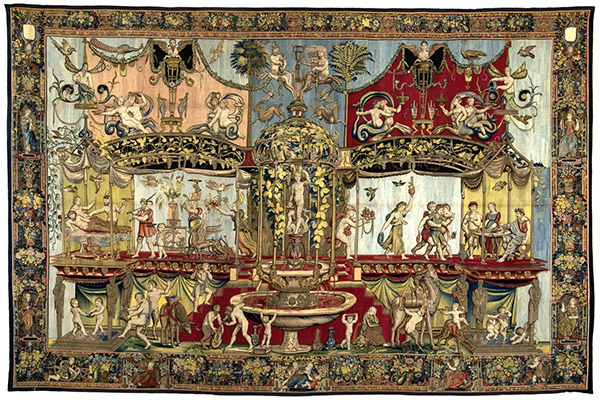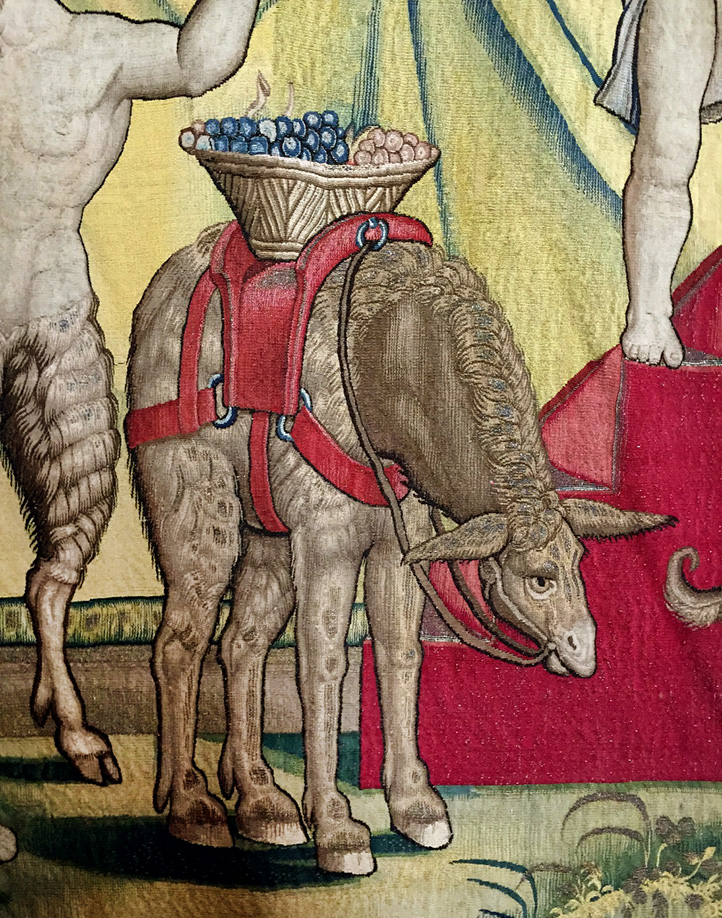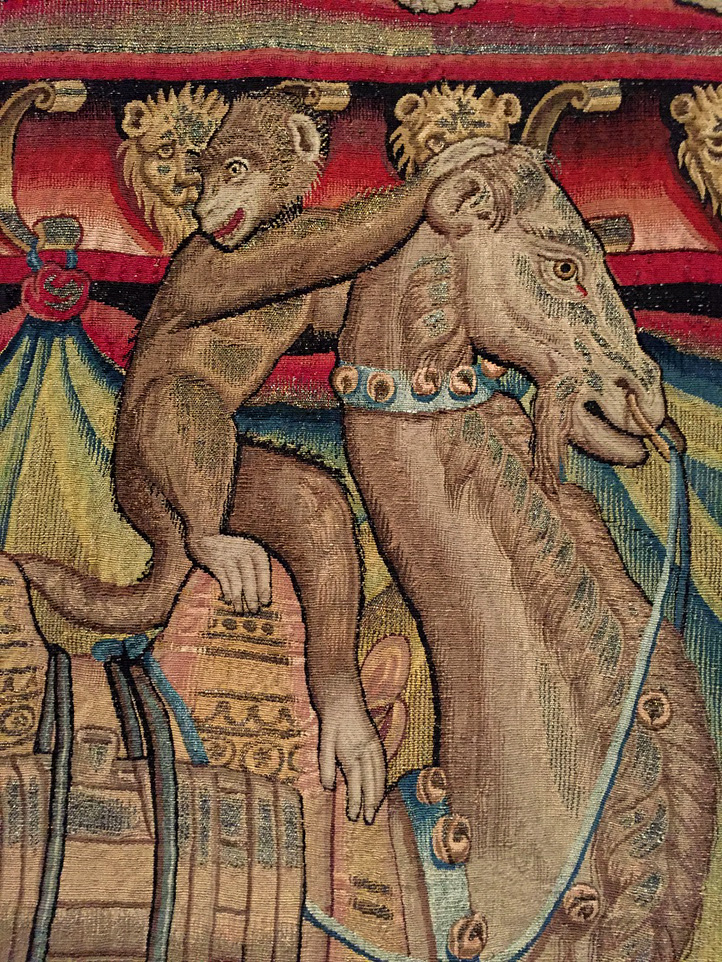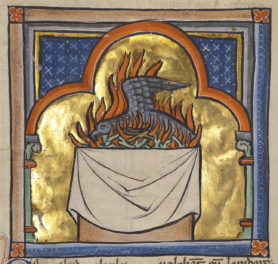
Triumph of Bacchus, about 1560, design by Giovanni da Udine under the supervision of Raphael; woven at the workshop of Frans Geubels, Brussels. Wool, silk, and gilt metal-wrapped thread. Courtesy of Le Mobilier National. Image © Le Mobilier National. Photo by Lawrence Perquis
As you enter the exhibition Woven Gold: Tapestries of Louis XIV (through May 1) at the Getty Center, your eye can’t help but go to the Triumph of Bacchus—a monumental tapestry celebrating the Roman god of wine. The size, vibrant colors, and abundant shimmering metal threads make this tapestry a particular highlight. However, at almost 16 feet high and just over 25 feet across, it can be difficult to appreciate all the tiny details and hidden narratives that appear in this tapestry from top to bottom without some background information.
This tapestry is from a later reweaving after a commission originally ordered around 1519 by Pope Leo X of the Medici family. It is one in a series called The Triumphs of the Gods. Though Bacchus may seem like an odd choice as the focus for a papal commission, intellectuals during Leo X’s reign may have understood this narrative as both a mythological depiction and an allusion to the sacramental wine and the sacred blood of Christ.
Perhaps in an effort to highlight the moral side of this subject, the border of this version, woven around 1560, features personifications of the cardinal virtues—Justice, Charity, Prudence, Faith, Hope, Fortitude, and Temperance. Ironically, Temperance—embodying the antithesis of Bacchus and his intoxicated company—calmly observes the central scene where Bacchus, standing atop of a fountain of wine, is surrounded by animated scenes of wine making and consumption.

The personification of the cardinal virtue Prudence woven into the border of Triumph of Bacchus. Tapestry courtesy of Le Mobilier National. Photo: Amelia Brown

Detail of the bottom section of the Triumph of Bacchus. Courtesy of Le Mobilier National. Image © Le Mobilier National. Photo by Lawrence Perquis
The tapestry is divided into three levels. On the first level at the bottom of the tapestry, which is most easily appreciated by visitors, wine is being made. On the viewer’s left, grapes are delivered by a sad, Eeyore-like donkey, who waits for satyrs and men to unload grapes from his back. A man pours the grapes into a press, where children stomp them into juice. Men and satyrs fill wineskins from the bountiful fountain and you can see one man carrying a wineskin up the stairs to the next level of the narrative. On the right, putti stomp grapes and one putto rides a leopard that carries grapes in side pouches. A monkey also approaches the wine press on the back of a large camel that carries wooden barrels—presumably to be filled with wine.

A donkey carries grapes in the tapestry Triumph of Bacchus. Tapestry courtesy of Le Mobilier National. Photo: Amelia Brown

A monkey rides a camel in the tapestry Triumph of Bacchus. Tapestry courtesy of Le Mobilier National. Photo: Amelia Brown
The center row shows Bacchus portrayed as an antique sculpture and standing in a central arbor. Flanking him are scenes from his life. On the viewer’s left is the rebirth of Bacchus from the thigh of Jupiter. Implanting the baby Bacchus in his thigh allowed Jupiter to save his son from dying with his mortal mother when she was exposed to Jupiter’s fiery glory of thunderbolts and lightning.

Detail of the middle section of the Triumph of Bacchus. Courtesy of Le Mobilier National. Image © Le Mobilier National. Photo by Lawrence Perquis
On the right is the drunken Silenus, one of Bacchus’s companions, being brought before Midas—an episode from the famous tale of King Midas who wished that everything he touched turned to gold. (Don’t miss the animal legs that support Midas’s table–it looks like it could walk away at any moment!)

Silenus brought before Midas. Image © Le Mobilier National. Photo by Lawrence Perquis
On the top level, pairs of hybrid “grotesque” figures are fed wine by attendants who are part man, part plant, and feature sumptuous moths’ wings.

Detail of the top section of the Triumph of Bacchus. Courtesy of Le Mobilier National. Image © Le Mobilier National. Photo by Lawrence Perquis

A grotesque with moth’s wings at the top on the viewer’s right. Image © Le Mobilier National. Photo by Lawrence Perquis
Even these figures hold lavish vessels filled with wine. Grotesques—an ornamental motif discovered during the excavation of Roman emperor Nero’s Domus Aurea (Golden House) at the end of the 15th century—were adapted by Renaissance artists like Raphael and spread across Europe through prints. Indeed, the symmetrical layout of Bacchus’s arbor and the fantastically imagined combinations of plants, animals, humans, vessels, and furniture in the Triumph of Bacchus follow the compositional arrangements and motifs often found in prints of the same period.
Finally, in the center, two goats perch on the top of the arbor. According to Ovid’s Metamorphosis, these creatures were sacrificed to Bacchus as punishment for chewing on vines and destroying grapes that could otherwise have provided wine.
Presiding over all of these episodes is Bacchus, of course, who at center triumphantly reaches to pick grapes from the arbor above.




Great lively piece about this tapestry and the industry of Bacchus! Take it with us to the exhibition before it closes!
I visited the exhibit when it first opened and it was great to later come across this explanation of what I saw. I like to spend my time looking at the art, so doing the reading later works for me.
Thank you!